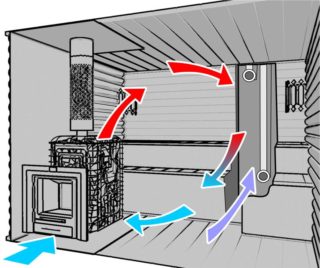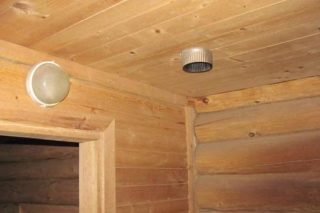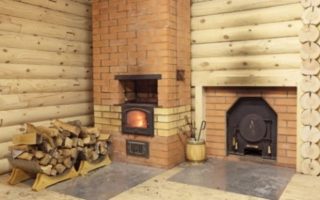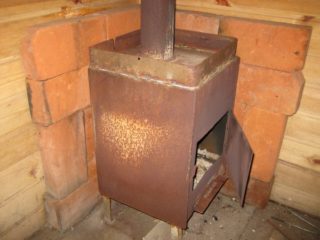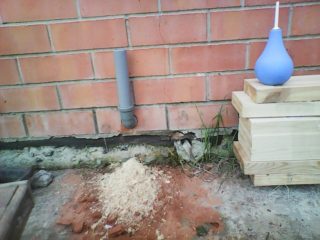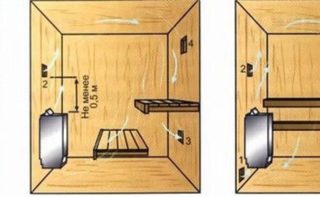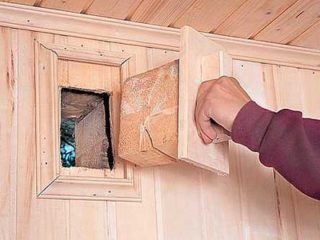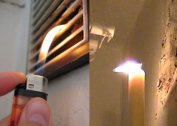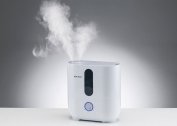Ventilation in the bath is necessary because it is built in such a way as to make it as airtight as possible. High temperature and humidity contribute to the formation of mold, and a lack of oxygen prevents normal combustion in the furnace and the breathing of people during bath procedures. It is especially important to have an effective ventilation system when using gas and solid fuel furnaces. Thanks to high-quality ventilation, an influx of fresh air is provided, the microclimate is normalized, the wood remains unchanged: it does not rot and does not become moldy, unpleasant odors are eliminated.
Types of ventilation
The principle of arranging ventilation in the bath and sauna is to organize the supply and exhaust system. Two holes are made for this purpose: inflow and outflow. Fresh air of lower temperature displaces heated.
You can not make an inflow from the room, for example, a dressing room, and an outflow to the street, or vice versa. Due to the temperature difference, such a system will not work properly. You can make an entrance and exit to the dressing room, but experts recommend that both of these openings go out into the street.
There are three ventilation options according to the principle of operation.
Natural
Such a system is very efficient, profitable and works due to the difference in temperature and atmospheric pressure. The location of the holes is determined based on the size of the steam room and the installation location of the furnace, shelves, material of the walls of the bath. According to general rules, the inflow in the bath is done below, and the hood is at the top.
Forced
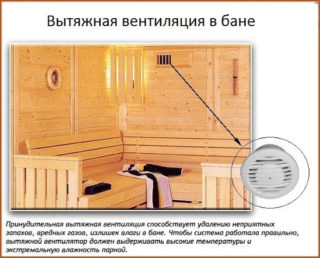 Forced ventilation involves the installation of fans on the supply and exhaust openings. You can purchase a special electronic device that allows you to adjust the temperature and humidity. Buying forced ventilation and installing it is much more expensive than arranging an autonomous system.
Forced ventilation involves the installation of fans on the supply and exhaust openings. You can purchase a special electronic device that allows you to adjust the temperature and humidity. Buying forced ventilation and installing it is much more expensive than arranging an autonomous system.
Benefits of forced ventilation:
- maintaining a given temperature and humidity level;
- uniform distribution of warmed air masses;
- accelerated air exchange;
- weather independent;
- the ability to install air filters.
Forced exhaust ventilation is optimal for quick drying and ventilation.
The risk of short circuit and fire due to wiring in a humid room increases.
Installation of forced ventilation is recommended in the following cases:
- The steam room (bath) has a large area.
- The bath is built of brick, foam blocks.
- It is not possible to correctly place the supply and exhaust openings.
- Powerful oven.
There are no particular difficulties when installing the equipment, but when acquiring forced ventilation, it is necessary to check that the device has maximum protection against moisture.
Combined
Combines the benefits of natural and forced ventilation. A fan is installed in the exhaust opening. In order to have the possibility of a natural inflow, it is necessary to arrange the inflow and outflow in accordance with the rules, then the flows of hot and cold air will mix.
The disadvantage of combined ventilation in the steam room is that to adjust the air exchange, the exhaust opening will sometimes need to be covered with a damper. This creates an undesirable load on the fan.If the hole is not closed, it is necessary to heat the room more intensively in order to maintain a high temperature.
General rules and nuances when planning ventilation in the bath
When planning ventilation in the bath, you need to determine the location of the holes. The larger they are, the faster the bath will be aired. The inflow and exhaust in the bath is equipped with control flaps. When closed, they must ensure tightness.
The difference in the diameters of the supply and output openings does not affect the ventilation. If the outlet passes 1 m³ of warm air per hour, exactly the same amount of cold air will be drawn into the room, only the flow rate with a narrower inlet will be higher. The effect of reverse traction occurs if the wind blows from the location of the exhaust hole in the wall or the inlet is closed.
When planning forced ventilation in a steam room, it is necessary to accurately calculate the fan performance. If it turns out to be too powerful, the air exchange will be too intense. To calculate the productivity, you need to find the volume of the room, multiplying the area by the height of the ceilings, and multiply the resulting value by the recommended rate of air exchange. For baths, this figure is five.
If it will be necessary subsequently to reduce the intensity of ventilation, you can set a timer so that the fan switches off at regular intervals.
Adjacent firebox
The firebox is taken out to the room adjacent to the steam room - a dressing room or a rest room. This placement has its advantages:
- In the relaxation room, you can arrange a fireplace, closing the firebox instead of the door with heat-resistant glass.
- The firebox heats not only the steam room, but also the adjacent room.
- In the rest room or dressing room it is convenient to allocate a place for storing firewood.
- The steam room does not accumulate dirt and debris.
The heating and ventilation device at the same time has some features. The furnace with the furnace is connected using a furnace tunnel. It is laid through an opening in the wall, performing thorough thermal insulation with basalt wool.
The inlet opening is made closer to the floor, positioning the end of the duct at the bottom of the furnace, at a distance of several centimeters from the metal sheet protecting the floor from fire. The ventilation in the steam room will work due to the ventilation channels of the furnace and the supply air duct. An exhaust hole is best placed on the opposite wall, 30 cm from the ceiling. It is recommended to make another hole under the shelves. Both holes must be connected with a vertical duct. The lower hood is ajar when procedures are taken in the steam room, the upper one is closed at this moment. It is such a system that will save heat and at the same time provide ventilation.
Fire chamber inside the steam room
If the firebox is located inside the steam room, the principle remains the same, but the supply ventilation scheme changes. It is necessary to equip the inflow channel to support the combustion process. The ventilation system is controlled by two doors located one above the other. First, open the lower, cold air does not flow. When the stove is warm, the upper door is ajar. The air in the steam room will circulate through the doors, gradually heating up more and more. When the temperature in the steam room becomes acceptable, the lower door is closed, and the upper one is left open. After complete warming, both doors are closed.
Existing ventilation systems
There are several rules and diagrams of the ventilation device in the bath. Their effectiveness has been proven by numerous examples from practice.
Inflow near the furnace
The ventilation hole can be placed next to the furnace, under or behind it, at a distance of 25-35 cm from the floor. Flow direction: along the floor, and then along the opposite wall. If the supply is located behind the furnace, the supply of oxygen will promote active combustion.
Blown as a hood
The furnace can perform the main function in the ventilation system. Effective ventilation is provided by extracting air from the steam room through the blower. In this case, the furnace is installed below the level of the finishing floor.
Heated air will be removed through the chimney, and it can enter the steam room in various ways:
- through the ajar door;
- through the hole at the bottom of the door, which is closed with a decorative grille;
- through the cracks in the floor;
- through the window.
In the latter case, an uncomfortable microclimate can be created in the steam room, since the window is usually located above the firebox, and the heater is on the opposite wall. Cold air will "cut" the steam, heading to the exhaust outlet, not having time to heat up.
The advantage is that the ventilation speed is controlled by opening and closing the oven doors. So that the air, getting into the room, has time to warm up, the inlet must be placed behind the stove.
Disadvantages:
- the presence of dead zones;
- dependence on weather conditions;
- low productivity.
The blower as an extract is suitable only for a small bath.
For a wet floor bath
In a bath with a leaking floor, where the top layer is represented by a grate, there is a high risk of rotting of the floorboards and the spread of mold, since the wooden floor is affected by steam, moisture from the soil and foundation, condensation. In this case, it is important to place the holes under the floorboards, in the wall or foundation. During ventilation, the upper surface of the floor will dry, and when the hood is opened, the lower surface will be dried. In this case, it is advisable to provide for the diversion of water outside the bathhouse when developing the project. Ventilation can be natural or forced. Despite the high efficiency of the system, drafts do not form.
Openings in one wall
This placement is not the best, but it takes place if other options are not suitable. For example, inflow and outflow on one wall is done if the remaining surfaces are adjacent to residential buildings. In this case, a fan must be installed on the exhaust outlet.
Recommendations for arranging ventilation
Since the bathhouse is several interconnected rooms, the ventilation problem is relevant for each of them.
- In the attic, a supply hole should be made under the roof canopy, and the hood should be made on the ridge.
- In the washing department, it is best to organize forced ventilation, due to which excess moisture will not accumulate.
- In the shower compartment, it is enough to make vents under the ceiling.
If each of the rooms is equipped with supply and exhaust openings, dampness can be avoided.
Since the dressing room is located next to the steam room, steam also penetrates here, condensation forms on the walls. Here you can design ventilation of a similar type or simply make windows that allow you to quickly ventilate the room.
Adjustment during use
A properly designed and equipped ventilation system is half the battle. If you do not know how to use it, there will be little sense from her.
Walkthrough:
- When the furnace just starts to melt, all openings - both supply and exhaust - are closed.
- If the temperature in the steam room has reached the desired values, you need to open the door of the furnace or gate valve.
- The more fresh air required, the more openings open.
- When airing the steam room after the procedures, the valves open completely.
The principle of adjusting the ventilation system when the furnace is located in the steam room is slightly different.
Thanks to a carefully designed ventilation system, it is possible to create a comfortable microclimate in the steam room and protect the tree from mold and rot. By adjusting, a constant flow of fresh air is provided during the bathing procedures and at the same time heat is maintained.
